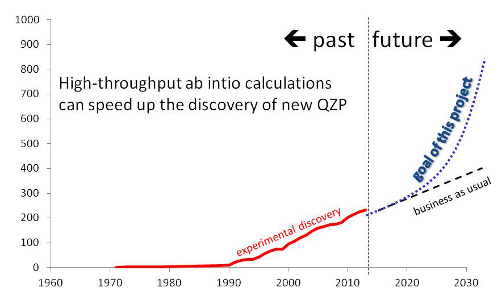Boosting the discovery rate of quaternary Zintl phases
Boosting the discovery rate of quaternary Zintl phases
Promotor(en): S. Cottenier /MM_14_MAT_03 / Solid-state physicsZintl phases are a distinct class of solids with a type of chemical bonding that has features similar to ionic as well as to covalent bonding. For this reason they combine behavior that is typical for metals (e.g. a typical metallic luster) with properties that are typical for insulators (brittleness, high melting point). Zintl phases typically consist of elements of groups 1 and 2 (alkali and earth alkali), combined with elements of groups 13-16 (early p-block). The prototype example is NaTl.
One application for which Zintl phases are considered to be particularly promising, is as thermoelectric material. Having an ideal thermoelectric would allow converting the ubiquitous waste heat from motors, devices and our body back into useful electricity. The performance of existing thermoelectric materials (e.g. Bi2Te3) is not yet sufficiently high to make this kind of power generation economically viable. Zintl phases have intrinsically complicated crystal structures, and this helps to provide materials with a very low lattice thermal conductivity – which is one of the requirements for a good thermoelectric material.
Hence, we want a Zintl phase with a crystal structure that is as complex as possible. The more elements are involved, the more complex the crystal structure can be. Ternary Zintl phases tend to have more complicated structures than binary ones. And quaternary Zintle phases (QZP) have more complicated structures than ternary ones. As the picture shows, there are less than 250 QZP known. Nearly all of them have been discovered since 1990, at a steady pace of about 10 per year. The goal of this thesis is to speed up this discovery rate: you will screen the search space of potential QZP materials by computational methods, which will allow you to point experimental crystal engineers to those QZP that are most promising to exist. Such an approach is likely to speed up the discovery rate of new QZP a lot.
It will not be your first goal to find a better thermoelectric material, but indirectly your results will contribute to this search: the larger the pool of known QZP will be, the more chances one will find a better thermoelectric among them.

Goal
The search space of all possible QZP contains hundreds of thousands of candidates, and it is not feasible to scan all of those in one year. You will start with a subclass of 1:1:1:4 stochiometry, for which already 6 QZP are experimentally known (orthorhombic structure). You will screen the 1000 other candidates in this class, assuming a constant orthorhombic structure. A separate branch in the same topic could be to use structure prediction methods to inspect whether the orthorhombic structure is really the best one over the entire search space, and to screen subsequently the same candidates in the other structures that are possibly found. Later on, a similar approach can be used to examine other stoichiometries for which only one or no experimental QZP is known.
- Study programmeMaster of Science in Engineering Physics [EMPHYS], Master of Science in Physics and Astronomy [CMFYST], Master of Science in Sustainable Materials Engineering [EMMAEN]

